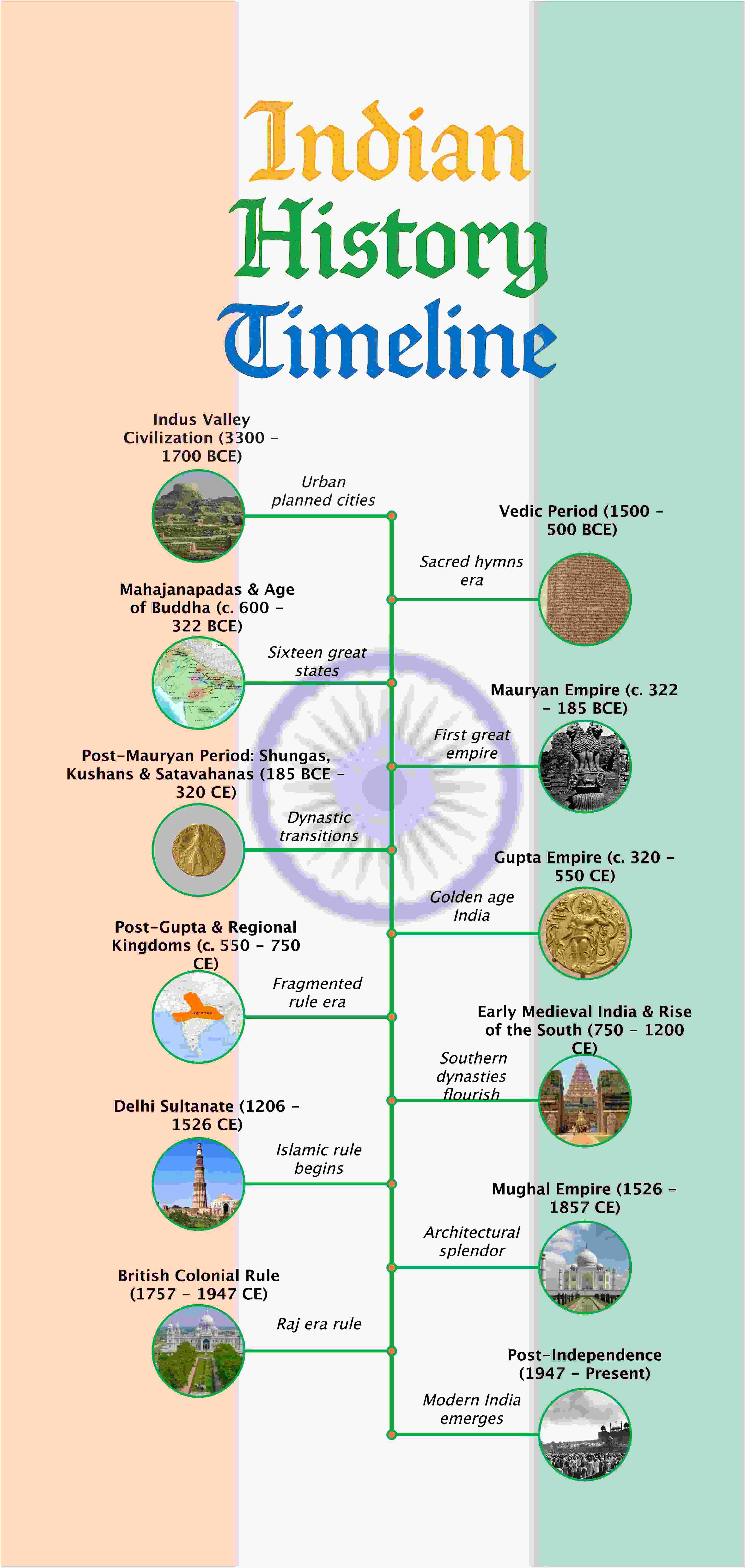"India is the cradle of the human race, the birthplace of human speech, the mother of history, the grandmother of legend, and the great-grandmother of tradition," says Mark Twain.
The history of India begins with the Indus Valley Civilization around 3300 BCE, one of the world’s oldest. That’s more than 5,000 years of ideas, empires, art, and revolutions. From ancient trade routes to Mars missions, India has never stopped moving.
This timeline takes you from the Mauryas and Guptas to the Mughals, the British Raj, and independence. Each era changed the land, from stone tools to nuclear power.
And it all began along the banks of the Indus River. Let’s discuss the complete Indian history timeline now to relive the ages.
In this article
Indian History Timeline
India’s past is deep, colorful, and full of turning points. Ancient cities rose with perfect planning. Mighty kingdoms ruled millions. Teachers shaped the world’s great religions. Poets and scientists worked side by side with warriors and rulers. Each era brought change, challenge, and new ideas. Some moments brought unity; others brought division. But the story kept moving forward.
But to understand where we are now, we need to see where it all began. Let’s explore the past through this timeline, step by step, era by era.
Indus Valley Civilization (3300 - 1700 BCE)
This was one of the first great civilizations on Earth. Cities like Mohenjo-daro and Harappa had straight streets, strong brick houses, and advanced drainage systems. Mohenjo-daro’s engineers built drains so well that some say they are still better than many cities today.
We still can’t read their writing, but we know they traded far and wide. They made pottery, jewelry, and tools. They built their cities with careful planning.
There were no giant palaces or signs of big wars. It looks like they lived in peace. Mysterious, smart, and far ahead of their time.
Vedic Period (1500 - 500 BCE)
Around this time, Indo-Aryans came into India. They spoke Sanskrit and composed the Vedas, collections of hymns and prayers. These became the base of Hindu traditions.
Life was based around rivers, farming, and cattle. People worshipped nature, performed fire rituals, and told stories by word of mouth.
During this period, the first signs of caste appeared. Kings and priests shared power. This was the start of India’s deep spiritual and philosophical roots.
Mahajanapadas & the Age of Buddha ( 600 - 322 BCE)
Around 600 BCE, India was divided into 16 powerful kingdoms called Mahajanapadas, such as Magadha, Kosala, and Vatsa. Cities expanded with busy markets, skilled craftsmen, and growing trade networks linking distant lands. Rulers fought for territory, wealth, and dominance.
This was also a turning point for spiritual thought. Siddhartha Gautama, the Buddha, shared his teachings on ending suffering. Mahavira, founder of Jainism, preached truth, non-violence, and simplicity. It was an age where political rivalry and profound ideas shaped India’s future.
Mauryan Empire ( 322 - 185 BCE)
Chandragupta Maurya, guided by his adviser Chanakya, built the first large empire across most of India.
His grandson Ashoka started as a warrior king. But after the bloody Kalinga war, he turned to Buddhism. He spread messages of peace, tolerance, and non-violence. His orders were carved into rocks and pillars, which are India's earliest written records.
The Mauryan Empire was about power, trade, and moral change all at once.
Post-Mauryan Period (185 BCE - 320 CE)
After the Mauryas, smaller kingdoms took control. The Shungas ruled in the north. The Satavahanas dominated the Deccan. The Kushans, from Central Asia, ruled the northwest and linked India to the Silk Road.
Trade flourished, bringing gold, silk, spices, and fresh ideas. Gandhara art, blending Greek and Indian styles, became famous. King Kanishka of the Kushans played a key role in spreading Buddhism across Asia.
It was a time of cultural exchange, political shifts, and artistic brilliance.
Gupta Empire (320 - 550 CE)
The Guptas created what is called India’s “Golden Age.” They brought peace, prosperity, and a deep love for learning.
In this time:
- The concept of zero was developed.
- Astronomy, mathematics, and medicine advanced greatly.
- Sanskrit poetry and plays reached new heights.
- Temples with detailed carvings were built.
- And, trade routes expanded across land and sea.
Scholars like Aryabhata, the mathematician, and Kalidasa, the poet, became legendary. It was an age of stability, creativity, and knowledge that shaped India’s future
Post-Gupta & Regional Kingdoms ( 550 - 750 CE)
When the Gupta Empire fell, India broke into smaller kingdoms. Harsha rose in the north, ruling with skill and diplomacy. In the south, the Pallavas built grand stone temples and promoted learning.
Each region developed its own art, architecture, and language. Kings supported poets, scholars, and builders. Trade continued, and culture flourished in many centers at once.
India was no longer one empire. It was a land of many kingdoms, each adding a unique chapter to the same story.
Early Medieval India & Rise of the South (750 - 1200 CE)
Powerful southern dynasties like the Chalukyas, Rashtrakutas, and Cholas rose.
The Cholas were famous for their grand temples, bronze sculptures, and strong naval fleets. They traded with Southeast Asia and spread Indian culture abroad.
In the north, the Palas supported Buddhist learning at Nalanda University. The Bhakti movement began, focusing on personal devotion to God over rituals.
Delhi Sultanate (1206 - 1526 CE)
Rulers from Central Asia came and set up the Delhi Sultanate. Over 300 years, several dynasties ruled: Mamluks, Khiljis, Tughlaqs, Sayyids, and Lodis.
They brought Persian art, architecture, and new farming techniques. The Qutub Minar was built. Sufi saints spread messages of love and unity.
It was a time of both cultural mixing and political conflict.
Mughal Empire (1526 - 1857 CE)
Babur founded the Mughal Empire. His grandson Akbar, made it strong through both war and diplomacy.
The Mughals blended Indian and Persian styles in art, gardens, and buildings. The Taj Mahal became their greatest monument. Akbar encouraged discussion between different religions.
But over time, the empire weakened. By the 1700s, the British were becoming powerful.
British Colonial Rule (1757 - 1947 CE)
The British first came as traders through the East India Company. After the Battle of Plassey in 1757, they began taking control.
In 1857, a major revolt shook their rule, but it failed. After that, the British Crown ruled directly.
They built railways, schools, and courts. But they also caused famines, took resources, and hurt local industries.
Leaders like Mahatma Gandhi led the fight for independence. Finally, in 1947, India was free, but the country was split into India and Pakistan.
Post-Independence (1947 - Present)
India’s first years were full of challenges. The country had to rebuild its economy, unite its people, and strengthen democracy.
It faced wars, poverty, and political struggles. But it also grew in science, education, and industry.
Today, India is:
- The world’s largest democracy
- A fast-growing economy
- A nation rich in diversity and history
From the bricks of Harappa to missions to Mars, India’s journey is still going.
How to Make an Indian History Timeline in EdrawMax?
India’s history stretches from the Indus Valley to the present day. There are thousands of years of events, rulers, ideas, and inventions. Putting all that in text can feel confusing.
But EdrawMax can make it simple. Turn plain notes into a colorful timeline that’s easy to read. Choose a ready-made template, add your events, and arrange them in order. Let’s create an Indian history timeline step by step.
Step1Login & Create a New File
- Download and install EdrawMax on your computer.
- Once installed, open the app and sign in with your Wondershare ID or linked social account.
- In the left sidebar, click Home. At the top blue category bar, select Basic Diagram.
- From the list, click Timeline to browse templates.
- You can also use the search box at the top-right and type timeline to find them instantly.

Step2Choose a Template
- In the Local Templates section, you’ll see a list of templates.
- Pick one that matches what you want. If you like, you can start fresh by choosing Blank Drawing.
- Double-click your choice to start working on it..
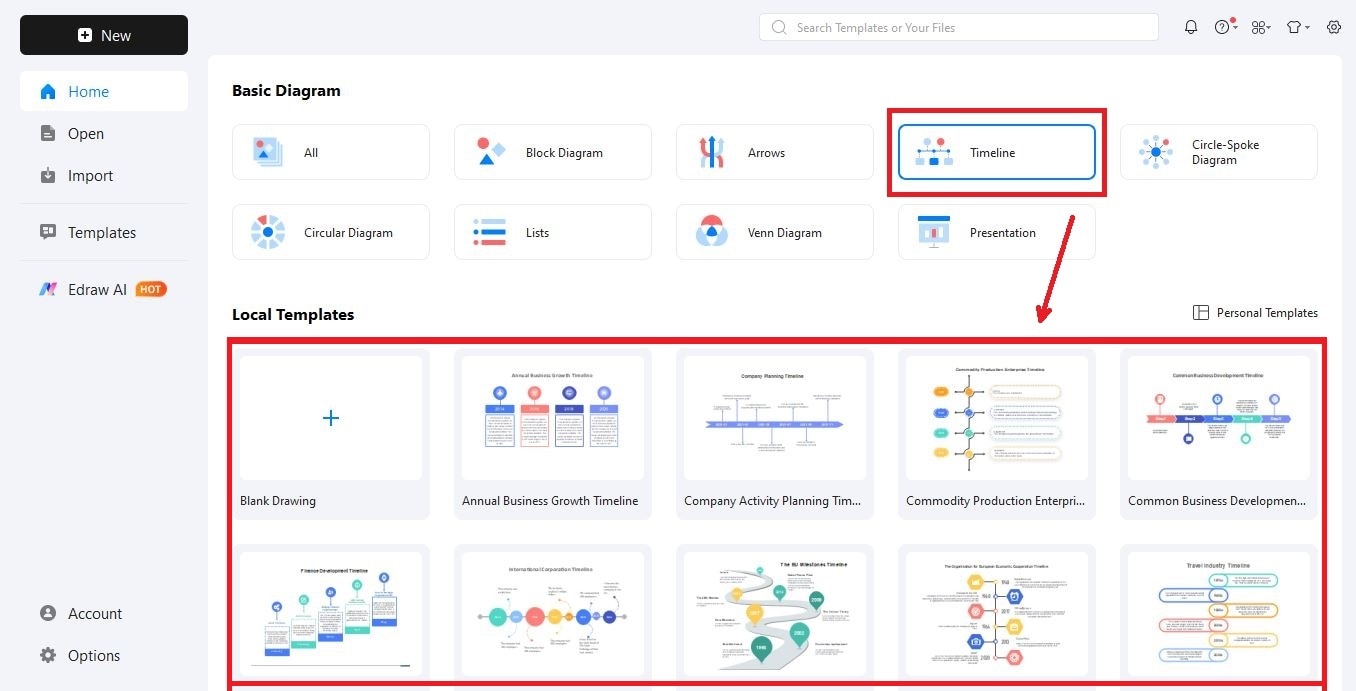
Step3Add a Title and Event Text
- From the Home tab (top toolbar), click Text to add a bold title at the top of your timeline.
- To edit events, click any existing text on the canvas and replace it with your own dates, events, or descriptions.
- Double-click any label to edit, and use the floating toolbar to change font, size, color, and alignment.
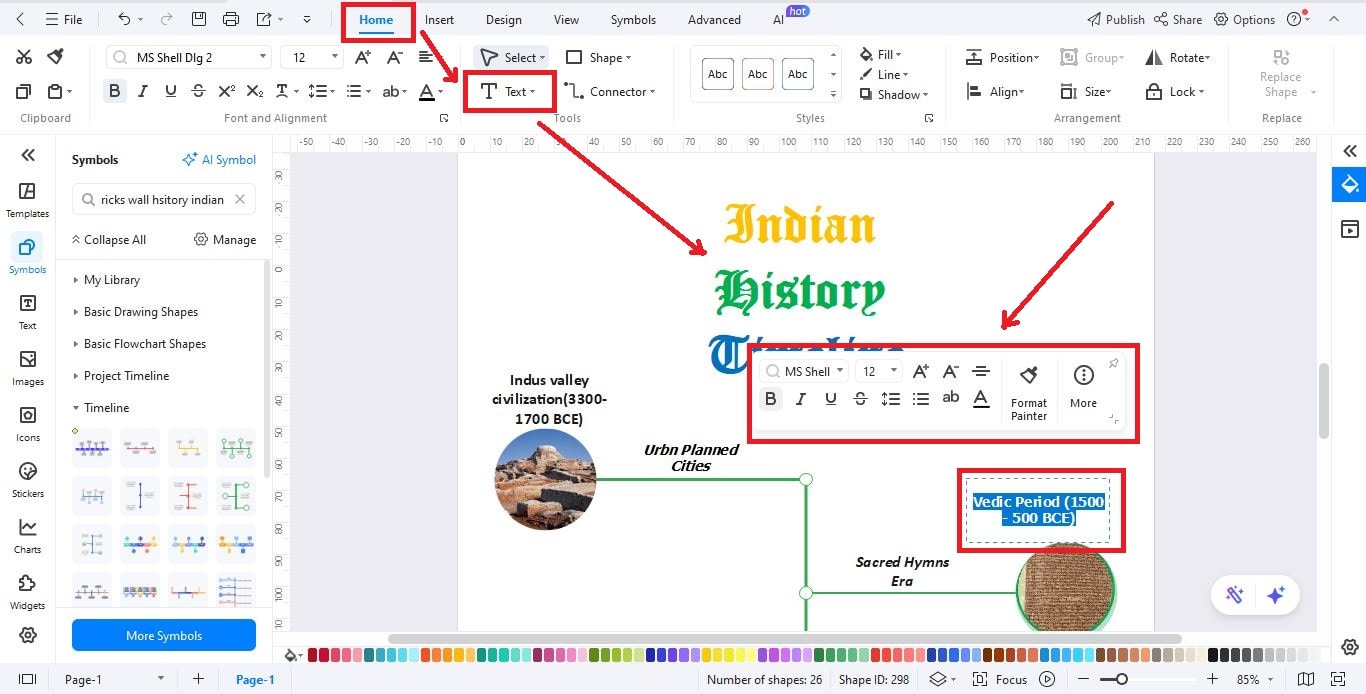
Step4Arrange and Link Events
In the Home tab, use:
- Select (left side) to move elements
- Text (next to Select) to add new labels
- Shape (center section) to create callouts or boxes
- Connector (right side) to draw linking lines between events
You can also add Symbols, Icons, Images, Stickers, or Charts from the left toolbar to make your timeline visually engaging.
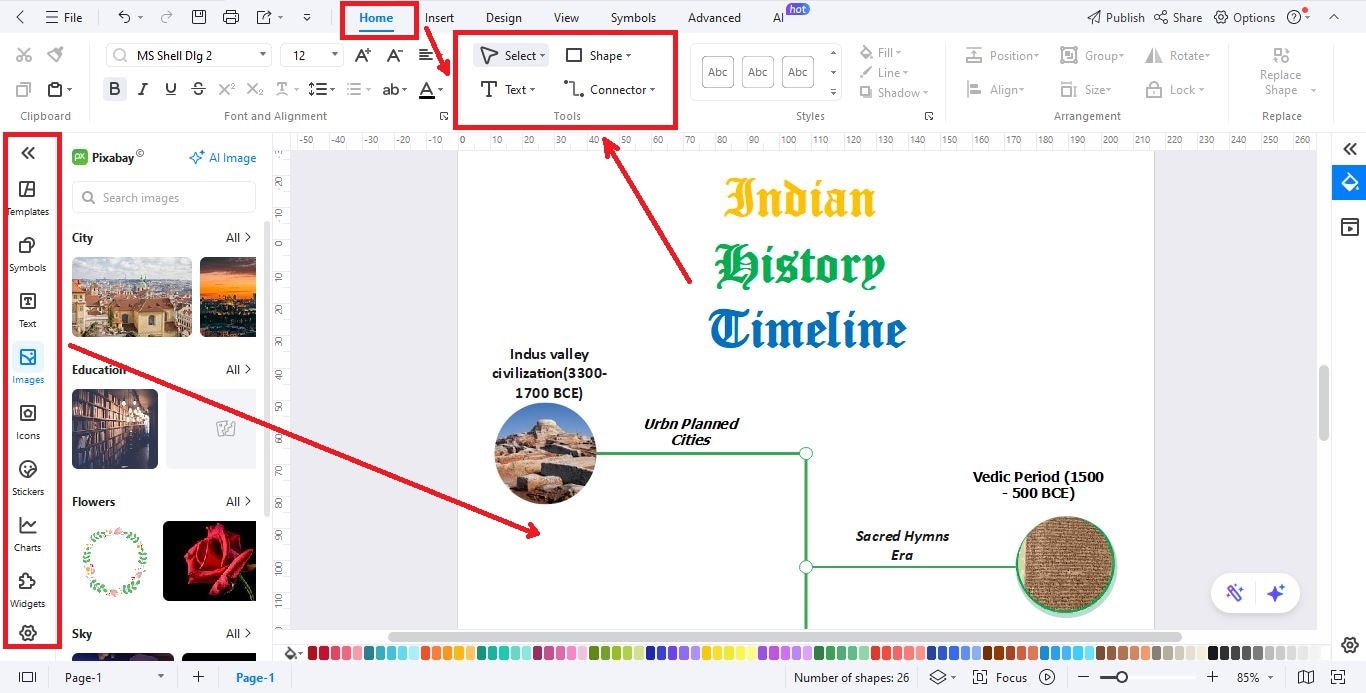
Step5Customize Timeline Design
- Select any object, then in the top Styles toolbar, adjust Fill, Line, and Shadow.
- Use the bottom color palette to apply theme colors.
- To arrange elements, use Position, Align, Size, Group, Rotate, or Lock in the Home tab.
- In the Symbols panel (left), click More Symbols for additional shapes.

Step6Add a Background Image
- In the Insert tab (top toolbar), click Picture to add from your computer or EdrawMax’s library. You can also paste directly from Google.
- Select the image, choose Send to Back (floating toolbar), then reduce opacity via Adjust. Right-click the image and choose Move to Layer to lock it.
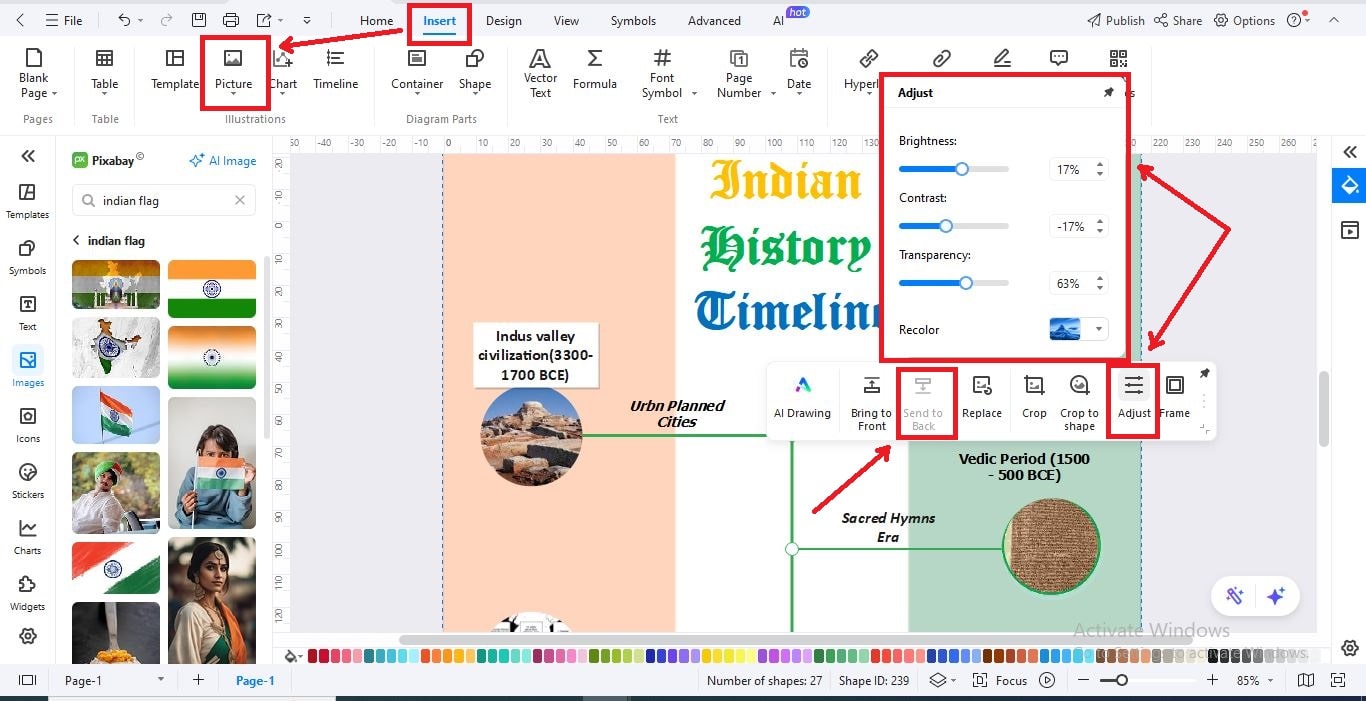
Step7Save, Share or Export Your Timeline
- From the File menu (top-left), click Save to keep an editable copy.
- To share, click Share (top-right).
- And for exports, go to File > Export and choose PNG, PDF, SVG, HTML, Visio, or Excel.
- You can also click the down arrow next to Share and choose Publish to post your design in the EdrawMax community.
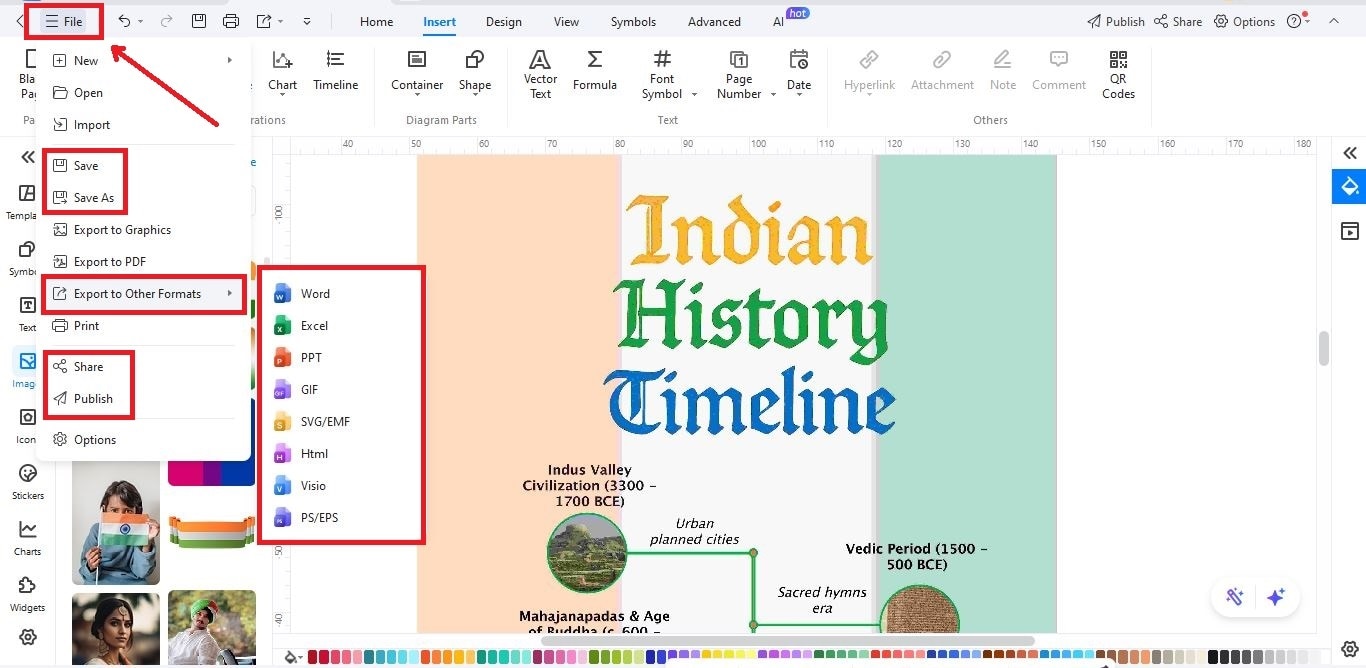
Wrapping Up
India’s journey from ancient civilizations to today’s modern world is truly inspiring. Its rich history shows how science, culture, and resilience have shaped a nation full of hope and progress. Each era adds a new chapter to this incredible story.
If you want to explore India’s past and see how it all connects, EdrawMax is the perfect tool. It helps you create clear, colorful timelines quickly and easily. Try EdrawMax for free and start building your own history timeline today!




